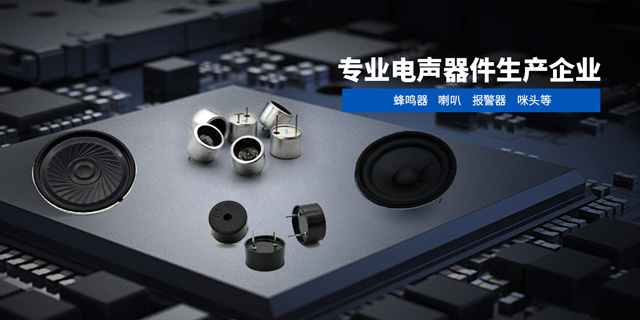The difference between active buzzer and passive buzzer
Release time:
2021-11-29
buzzer is a commonly used pronunciation device, commonly found in single chip microcomputer experiment board and children's toys. Is it distinguished from the sound? Some only emit sounds of a certain frequency, while others emit clear sounds. So, let's understand the difference between active buzzer and passive buzzer!

Classification and Principle of 1. Buzzer
Buzzer: The piezoelectric effect of piezoelectric ceramic sheet is used to make sound. The DC resistance is infinite and the AC impedance is also large.
Moving the horn: Generally, the coil of the permanent magnet field is used to move the corn paper to make sound. The DC resistance is almost 0, and the AC resistance is generally a few euros to a dozen euros.
Buzzer: The drive requires a large voltage, but the current is small, a few milliseconds will do. Power is also small.
Moving the horn requires a lot of current, but the voltage is not high. Power can be great.
Buzzer: The frequency characteristic is not good, it cannot be said to be the sound quality. It will only ring.
Horn: Now it's time to stick to sound quality.
is now commonly used active buzzer, internal oscillation, drive circuit. It will ring when the power is turned on. I think that's what you're saying. The advantage is that it saves the trouble of using it, but the disadvantage is that it becomes a single tone after the frequency is fixed.
The difference between 2. active buzzer and passive buzzer is mainly different
The fundamental difference between active buzzer and passive buzzer is that the product has different requirements for input signals. The ideal signal for the buzzer to work is DC, usually displayed as VDC, VDD, etc. Because the buzzer has a simple oscillation circuit inside, it can convert a certain direct current into a pulse signal of a certain frequency, and send a magnetic field from the surface to make it alternate, so that the molybdenum sheet vibrates and pronounces. However, there are also active buzzers that work in specific AC signals, which only require high voltage and frequency of AC signals, and generally do not use this mode of operation. Passive buzzers have no internal drive circuit and are called buzzers in some companies and factories and speakers in national standards. Passive buzzer work with ideal signal square wave. When the pre-DC signal buzzer does not respond, it cannot be pronounced due to the constant magnetic circuit and the vibration of the molybdenum sheet.
In the latter case, their differences are as follows.
electromagnetic passive buzzer is an inductive load element. The ideal input mode is a forward square wave, usually expressed by VO-P. According to the passive buzzer is a capacitive load device, the ideal input is usually expressed as a two-way square wave VP-P. However, if the IC is an inverter 4049 or the like, input and output connection buzzers other than the acquisition gate are also desirable. However, the output power of the IC is too small, and sometimes the sound does not meet expectations. When the buzzer is used for high sound pressure alarm, the ordinary two-pin inductor can not meet the requirements. Generally, a 3-pin tapped inductor is used, which is usually 10 times the boost ratio. Some high sound pressure above 110dB may be boosted by a small power transformer.
The working principle of the 3. source buzzer
The working principle of the active buzzer is that the AC signal generates alternating magnetic flux on the valve stem of the bracket through the wire wound on the bracket, and the alternating magnetic flux The steady-state magnetic flux of the magnet overlaps, so that the molybdenum sheet vibrates at the specified AC signal frequency, and sounds in conjunction with the resonant cavity. The full frequency and sound pressure response curve of the product are directly related to the gap value, the natural frequency of the molybdenum plate (which can be roughly refracted as the thickness of the molybdenum plate), the shell) Helmholtz resonance sound cavity), and the wire diameter of the enameled wire with strong magnetism of the magnetic ring. The piezoelectric buzzer is made by sticking the piezoelectric ceramic sheet with high pressure and extreme pressure on the vibrating metal sheet. After applying an AC voltage, mechanical deformation and expansion are generated by the piezoelectric effect, and this characteristic is used to vibrate the metal sheet to make sound.
1. Peripheral support method-resonate the edge of the outer diameter of the fixed buzzer in the room. Usually no feedback buzzer, but the buzzer must be combined with the frequency of the resonance chamber to get a high sound pressure output, by the external oscillation circuit to generate a press signal, so that the buzzer sound.
2. Node support method-fix the buzzer plate in a ring structure with approximately the same diameter as the ceramic plate. If the resonator is properly designed, a combination of frequency-accurate FFT and positive FFT circuits can generate large sound pressures and accurate frequencies.
The above introduction is the difference between active buzzer and passive buzzer. If you need to know more, please feel free to contact us!
active buzzer
Next Page
Next Page
Latest News
Message
*Note: Please be sure to fill in the information accurately and keep the communication open, we will get in touch with you as soon as possible
Phone:+86-519-83822009
Phone: +86-13813568186
Fax: +86-519-88739926
Address: Zhenglu Town, Tianning District, Changzhou City, Jiangsu Province

